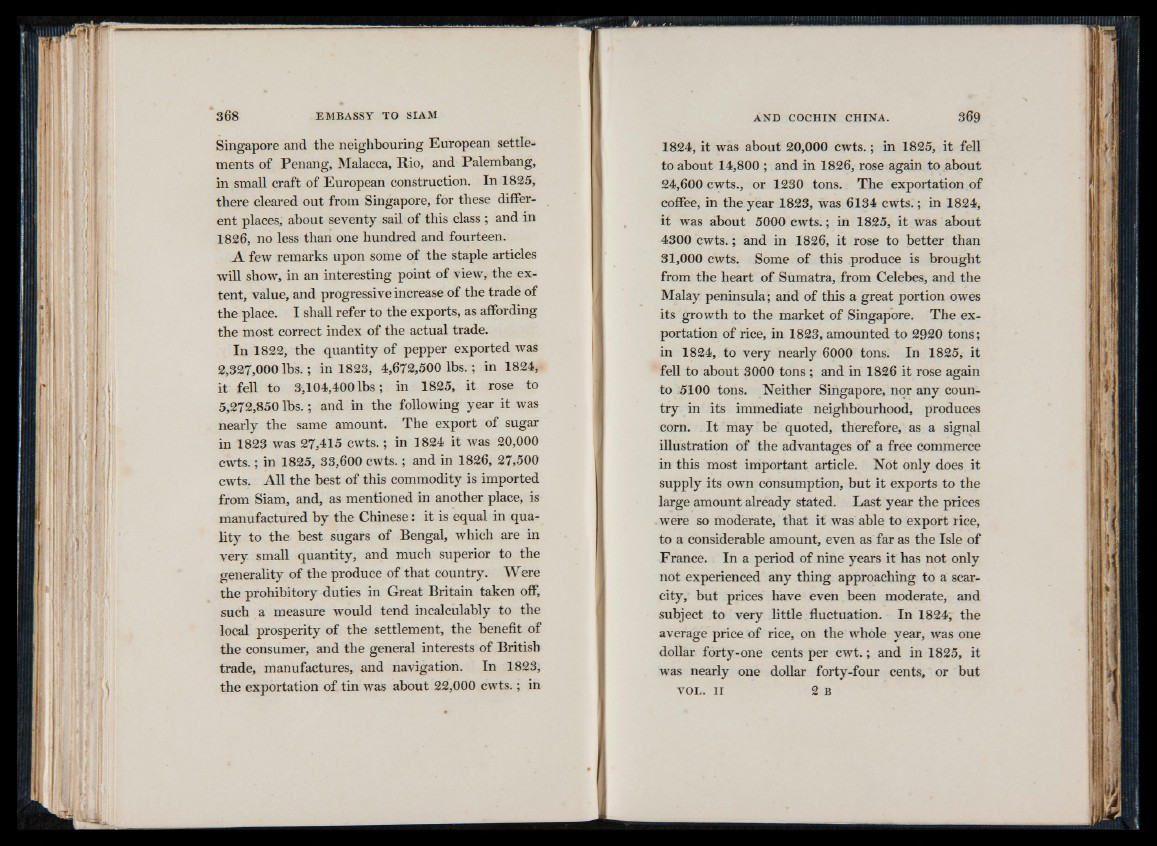
Singapore and the neighbouring European settlements
of Penang, Malacca, Rio, and Palembang,
in small craft of European construction. In 1825,
there cleared out from Singapore, for these different
places, about seventy sail of this class ; and in
1826, no less than one hundred and fourteen.
A few remarks upon some of the staple articles
will show, in an interesting point of view, the extent,
value, and progressive increase of the trade of
the place. I shall refer to the exports, as affording
the most correct index of the actual trade.
In 1822, the quantity of pepper exported was
2,327,000 lbs.; in 1823, 4,672,500 lbs.; in 1824,
it fell to 3,104,400 lb s ; in 1825, it rose to
5,272,850 lb s.; and in the following year it was
nearly the same amount. The export of sugar
in 1823 was 27,415 cwts.; in 1824 it was 20,000
cwts.; in 1825, 33,600 cwts.; and in 1826, 27,500
cwts. All the best of this commodity is imported
from Siam, and, as mentioned in another place, is
manufactured by the Chinese: it is equal in quality
to the best sugars of Bengal, which are in
very small quantity, and much superior to the
generality of the produce of that country. Were
the prohibitory duties in Great Britain taken off,
such a measure would tend incalculably to the
local prosperity of the settlement, the benefit of
the consumer, and the general interests of British
trade, manufactures, and navigation. In 1823,
the exportation of tin was about 22,000 cwts.; in
1824, it was about 20,000 cwts.; in 1825, it fell
to about 14,800 ; and in 1826, rose again to about
24,600 cwts., or 1230 tons. The exportation of
coffee, in the year 1823, was 6134 cwts.; in 1824,
it was about 5000 cwts.; in 1825, it was about
4300 cwts.; and in 1826, it rose to better than
31,000 cwts. Some of this produce is brought
from the heart of Sumatra, from Celebes, and the
Malay peninsula; and of this a great portion owes
its growth to the market of Singapore. The exportation
of rice, in 1823, amounted to 2920 tons;
in 1824, to very nearly 6000 tons. In 1825, it
fell to about 3000 tons ; and in 1826 it rose again
to 5100 tons. Neither Singapore, nor any country
in its immediate neighbourhood, produces
corn. I t may be quoted, therefore, as a signal
illustration of the advantages of a free commerce
in this most important article. Not only does it
supply its own consumption, but it exports to the
large amount already stated. Last year the prices
were so moderate, that it was able to export rice,
to a considerable amount, even as far as the Isle of
France. In a period of nine years it has not only
not experienced any thing approaching to a scarcity,
but prices have even been moderate, and
subject to very little fluctuation. In 1824; the
average price of rice, on the whole year, was one
dollar forty-one cents per cwt.; and in 1825, it
was nearly one dollar forty-four cents, or but
VOL. I I 2 b